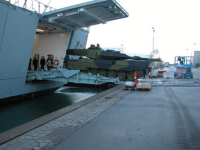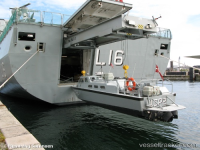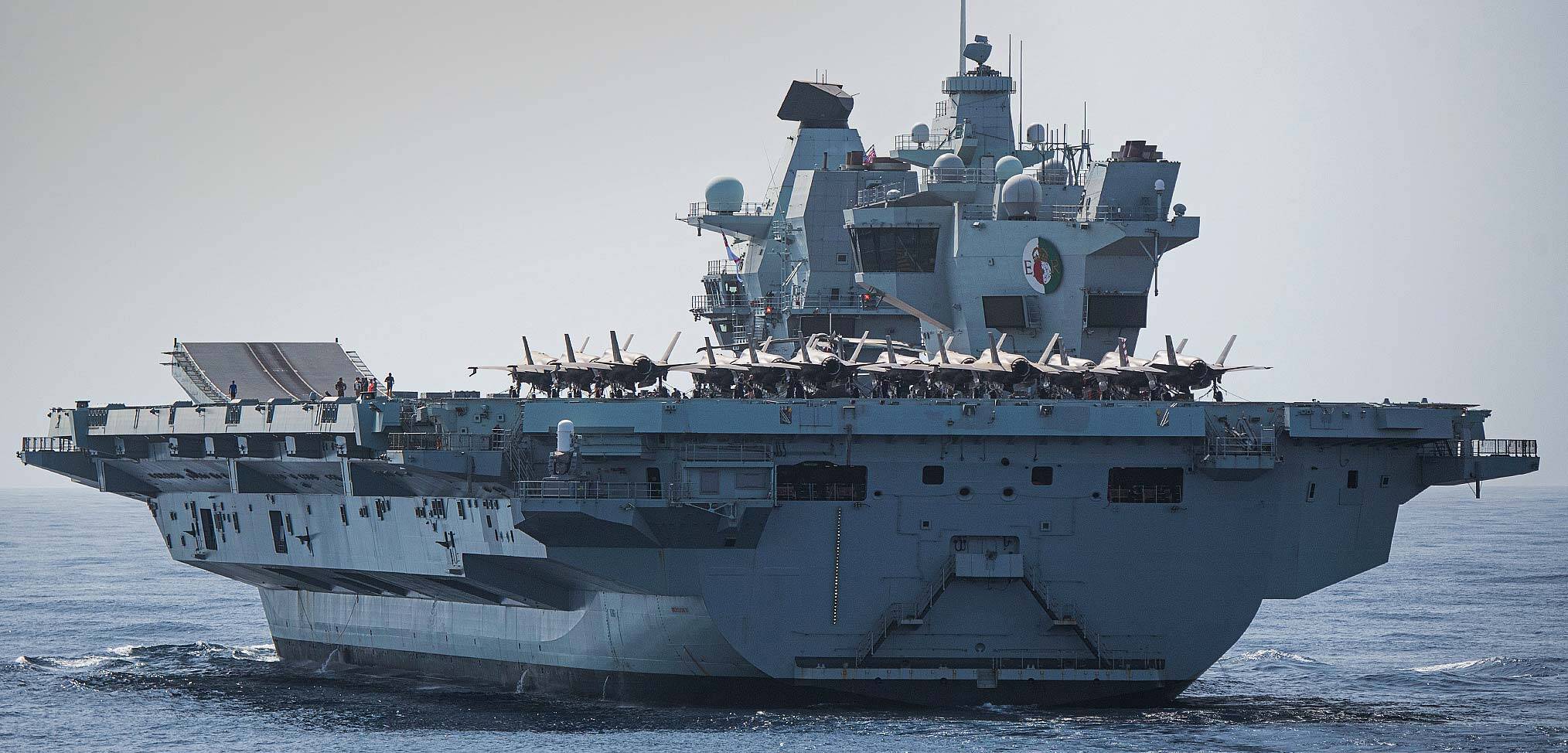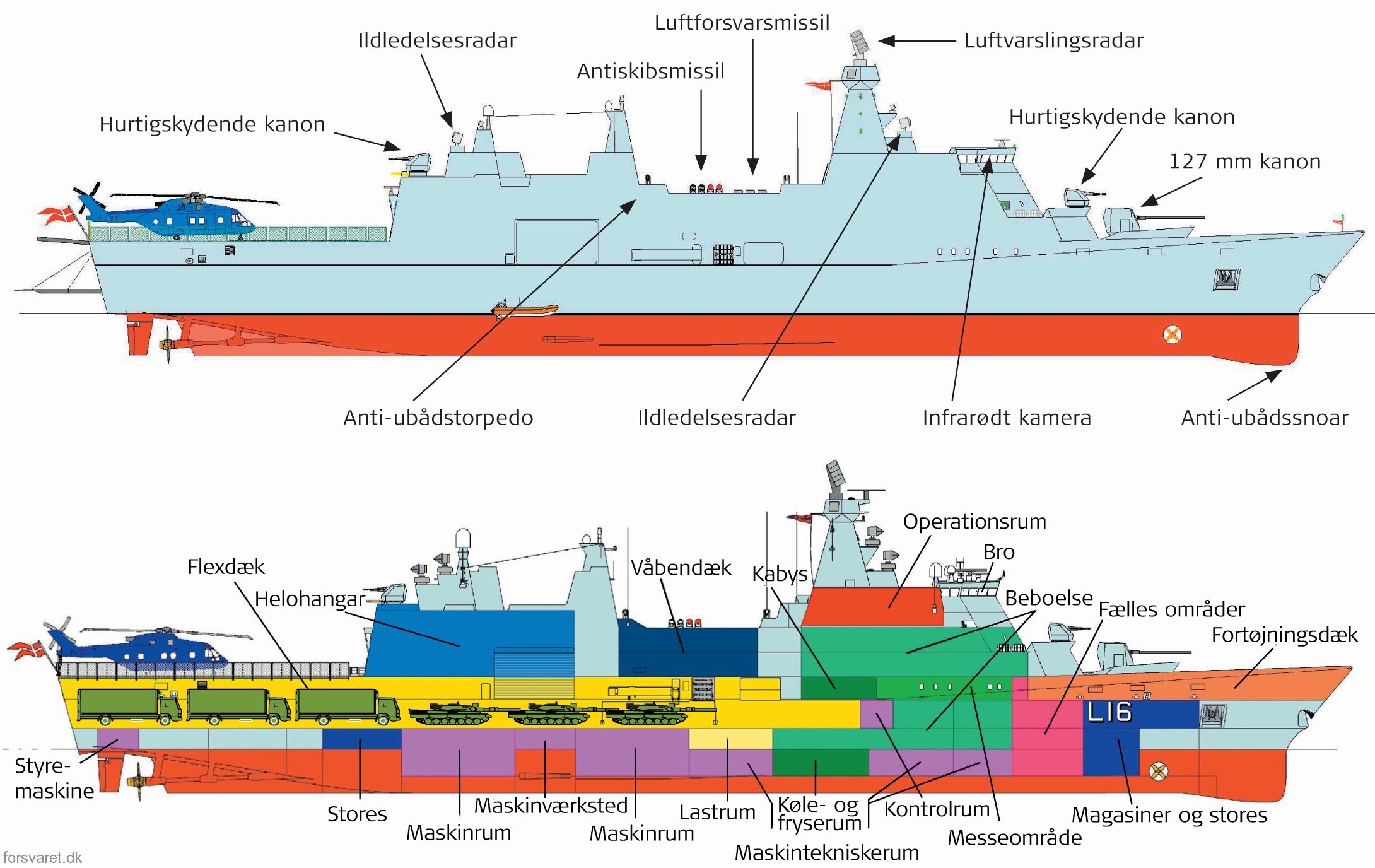- Reaction score
- 8,910
- Points
- 1,160
From the OG's post.
Well if the desire is for a minimally manned hull capable of launching helicopters, boats and tanks, of acting as a mothership for minewarfare, anti-piracy operations, command and support of shore operations, transport, supporting small units and being suitable for anti-submarine warfare and convoy escort duties - and you want to keep it in the low end of the Enforcer displacement range at 7000 tonnes - might I suggest this MOTS design.



Absalon begat the Iver Huitfeldt which begat the Arrowhead which begat the Type 31 which begat the Polish Miecznik frigates.
Canadian version - take 15 CSCs and put large flex decks in 6 of them.
Key User Requirements
Defining the requirements for MRSS-LPX will be complicated as there are some conflicting demands and hot debates about the direction of amphibious warfare. Both the Royal Marines and the Dutch Korps Mariniers are reconfiguring their commando forces to operate in smaller, more agile, dispersed and highly networked teams. The ever-increasing vulnerability of a stationary vessel positioned close to the shore suggests troops, weapons, vehicles and their logistic support will have to travel longer distances from the main assault platform. This in turn suggests greater reliance on helicopters. Albion and Bulwark’s lack of hangar facilities has long been regretted as a major weakness.
Assuming the ambition for Littoral Strike extends beyond light raiding, then heavy equipment and stores will still have to come ashore by boat. A helicopter carrier (LPH) is not the solution and a well dock will remain a key part of the design. The Landing craft (LCU) will also need to be faster, capable of independent operation over longer ranges and in higher sea states than the slow craft Royal Marines make do with today. Good aviation facilities and a well dock for capable LCUs appears to demand a large ship.
There will be a balance to be struck between size, expense and capability. It may be possible to go for a smaller LPD depending on the total force projection requirement. The aim is to have the KURs agreed by both parties by the end of this year. These will dictate space for troop accommodation, lane-meters for vehicles, hangar capacity and the ship’s displacement. 19,500 tonne HMS Albion is designed to carry around 400 marines with 65 assorted vehicles and has good command and control facilities. 14,000-tonne HMNLS Rotterdam can carry around 600 troops and similar vehicle numbers to Albion. The Bay class have a smaller well dock, accommodation for 356 troops but a large vehicle deck reflecting their cargo-carrying role. (In all ships at least 30% more troops can be carried in austere conditions if required).
At this stage, it is difficult to predict what MRSS-LPX may eventually look like. In the Netherlands, Damen has developed their Enforcer LPD concept with variants of various sizes aimed at both the domestic and export markets. The smallest ‘Enforcer 7000’ is 121m in length up to the ‘Enforcer 13000’ which is 163m in length. (The number denotes the approximate displacement in tonnes). In the UK, BMT have proposed the ELLIDA MRSS concept, although this vessel emphasises the logistic support element and includes replenishment at sea capabilities which is likely outside the scope of the current requirements. In both cases, these are still outline designs that would need a lot more work to mature them to the point of manufacture.
Something of a complication is the RNLN desire for the programme to encompass the replacement for their 4 large OPVs of the Holland class, built 2010-11. There does not seem to be a great deal of synergy between the very different capabilities and size of an OPV and an LPD, other than possibly cost-savings derived from a common hull.
Well if the desire is for a minimally manned hull capable of launching helicopters, boats and tanks, of acting as a mothership for minewarfare, anti-piracy operations, command and support of shore operations, transport, supporting small units and being suitable for anti-submarine warfare and convoy escort duties - and you want to keep it in the low end of the Enforcer displacement range at 7000 tonnes - might I suggest this MOTS design.
General characteristics Type Frigates (formerly support ships) Displacement Length 137 m (449 ft 6 in)[1] Beam 19.5 m (64 ft 0 in)[1] Draft 6.3 m (20 ft 8 in)[1] Propulsion Speed 24 knots (44 km/h)[1] Range 9,000 nmi (17,000 km) at 15 kn (28 km/h)[1] Boats & landing
craft carried2 × RHIBs, 2 × SB90E LCP Complement 100, plus aircrew and transients (accommodation for up to 300 in total) Sensors and
processing systemsElectronic warfare
& decoys
- 4 × 12-barrelled Terma DL-12T 130 mm decoy launchers
- 2 × 6-barrelled Terma DL-6T 130 mm decoy launchers
Armament
- 5 × StanFlex modules, typically:
- 3 × 12 RIM-162 ESSM SAM in Mk 48Mod3/ Mk 56 VLS
- 2 × 8 Harpoon Block II SSM
- Fixed weapons:
- 1 × 5"/62 Mk 45 mod 4 gun
- 2 × Mk32 Mod 14, each with 2 × MU90 torpedoes
- 2 × Millennium 35 mm CIWS
- 7 × 12.7 mm M/01 LvSa HMG
Aircraft carried 2 × AW-101 helicopters[1] or 2 MH-60R helicopters Aviation facilities Aft helicopter deck and hangars
Production started at Odense Steel Shipyard on 30 April 2003,[1] with the lead ship Absalon laid down on 28 November of that year.[1] Esbern Snare followed on 24 March 2004; they were both launched later that year.[1] They were delivered on 19 October 2004 and 17 April 2005 respectively, and commissioned on 10 January 2005 and 17 June 2005.[1] At this point they had the StanFlex modules installed, but would have to wait until 2007 for full operational capability,[1] with the installation of the 35mm CIWS, Mk32 torpedo launchers and Seagnat/SRBOC decoy systems.
Among other upgrades the two ships of the Absalon class were fitted with the newer Terma Scanter 6002 to replace the Scanter 2001 in 2020.
For political reasons, the ships were originally launched as "Flexible support ships" to avoid antagonising Russia after the end of the cold war.[8] On the 16th of October 2020, both ships were reclassed as anti-submarine warfare-frigates. Both ships will be upgraded with towed array sonars in addition to the existing, hull-mounted sonar. The Sikorsky SH-60 Seahawk helicopters will be equipped with dipping sonars, sonobuoys and torpedoes. This upgrade is expected to complete in 2026.[9]



Absalon begat the Iver Huitfeldt which begat the Arrowhead which begat the Type 31 which begat the Polish Miecznik frigates.
Canadian version - take 15 CSCs and put large flex decks in 6 of them.



